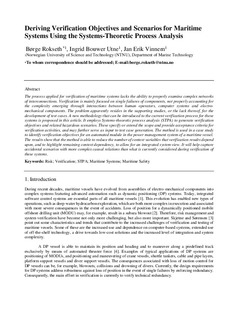| dc.contributor.author | Rokseth, Børge | |
| dc.contributor.author | Utne, Ingrid Bouwer | |
| dc.contributor.author | Vinnem, Jan Erik | |
| dc.date.accessioned | 2018-01-19T16:24:04Z | |
| dc.date.available | 2018-01-19T16:24:04Z | |
| dc.date.created | 2018-01-15T13:02:32Z | |
| dc.date.issued | 2018 | |
| dc.identifier.citation | Reliability Engineering & System Safety. 2018, 169, 18-31. | nb_NO |
| dc.identifier.issn | 0951-8320 | |
| dc.identifier.uri | http://hdl.handle.net/11250/2478446 | |
| dc.description.abstract | The process applied for verification of maritime systems lacks the ability to properly examine complex networks of interconnections. Verification is mainly focused on single failures of components, not properly accounting for the complexity emerging through interactions between human operators, computer systems and electro-mechanical components. The problem apparently resides in the supporting studies, or the lack thereof, for the development of test cases. A new methodology that can be introduced to the current verification process for these systems is proposed in this article. It employs Systems-theoretic process analysis (STPA) to generate verification objectives and related hazardous scenarios. These specify or extend the scope and provide acceptance criteria for verification activities, and may further serve as input to test case generation. The method is used in a case study to identify verification objectives for an automated module in the power management system of a maritime vessel. The results show that the method is able to reduce the number of context variables that verification results depend upon, and to highlight remaining context dependency, to allow for an integrated system view. It will help capture accidental scenarios with more complex causal relations than what is currently considered during verification of these systems. | nb_NO |
| dc.language.iso | eng | nb_NO |
| dc.publisher | Elsevier | nb_NO |
| dc.rights | Attribution-NonCommercial-NoDerivatives 4.0 Internasjonal | * |
| dc.rights.uri | http://creativecommons.org/licenses/by-nc-nd/4.0/deed.no | * |
| dc.title | Deriving Verification Objectives and Scenarios for Maritime Systems Using the Systems-Theoretic Process Analysis | nb_NO |
| dc.type | Journal article | nb_NO |
| dc.type | Peer reviewed | nb_NO |
| dc.description.version | acceptedVersion | nb_NO |
| dc.source.pagenumber | 18-31 | nb_NO |
| dc.source.volume | 169 | nb_NO |
| dc.source.journal | Reliability Engineering & System Safety | nb_NO |
| dc.identifier.doi | 10.1016/j.ress.2017.07.015 | |
| dc.identifier.cristin | 1542859 | |
| dc.relation.project | Norges forskningsråd: 223254 | nb_NO |
| dc.relation.project | Norges forskningsråd: 210670 | nb_NO |
| dc.description.localcode | © 2017 Elsevier Ltd. All rights reserved. This is the authors' accepted and refereed manuscript to the article, locked until 1 August 2019 due to copyright restrictions. | nb_NO |
| cristin.unitcode | 194,64,20,0 | |
| cristin.unitname | Institutt for marin teknikk | |
| cristin.ispublished | true | |
| cristin.fulltext | postprint | |
| cristin.qualitycode | 2 | |

